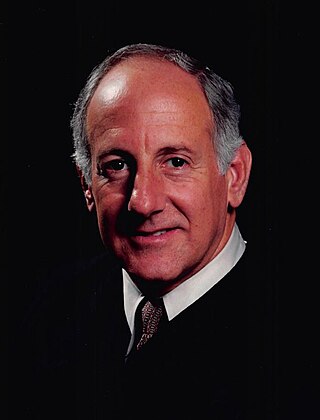Related Research Articles
In the United States, a state supreme court is the highest court in the state judiciary of a U.S. state. On matters of state law, the judgment of a state supreme court is considered final and binding in both state and federal courts.

The Tennessee Supreme Court is the highest court in the state of Tennessee. The Supreme Court's three buildings are seated in Nashville, Knoxville, and Jackson, Tennessee. The Court is composed of five members: a chief justice, and four justices. As of September 1, 2023, the chief justice is Holly M. Kirby.

The Supreme Court of Maryland is the highest court of the U.S. state of Maryland. The court, which is composed of one chief justice and six associate justices, meets in the Robert C. Murphy Courts of Appeal Building in the state capital, Annapolis. The term of the Court begins the second Monday of September. The Court is unique among American courts in that the justices wear red robes.

The Iowa Supreme Court is the highest court in the U.S. state of Iowa. The Court is composed of a chief justice and six associate justices.

The New York Court of Appeals is the highest court in the Unified Court System of the State of New York. It consists of seven judges: the Chief Judge and six associate judges, who are appointed by the governor and confirmed by the state senate to 14-year terms. The Chief Judge of the Court of Appeals also heads administration of the state's court system, and thus is also known as the Chief Judge of the State of New York. The Court of Appeals was founded in 1847 and is located in the New York Court of Appeals Building in Albany, New York.

The Supreme Court of Florida is the highest court in the U.S. state of Florida. It consists of seven justices—one of whom serves as Chief Justice. Six members are chosen from six districts around the state to foster geographic diversity, and one is selected at large.

Ronald Marc George is an American jurist. He previously served as the 27th Chief Justice of California from 1996 to 2011. Governor Pete Wilson appointed George as an associate justice of the Supreme Court in 1991 and elevated George to Chief Justice in 1996.
The Alaska Court System is the unified, centrally administered, and totally state-funded judicial system for the state of Alaska. The Alaska District Courts are the primary misdemeanor trial courts, the Alaska Superior Courts are the primary felony trial courts, and the Alaska Supreme Court and the Alaska Court of Appeals are the primary appellate courts. The chief justice of the Alaska Supreme Court is the administrative head of the Alaska Court System.

The Supreme Court of Texas is the court of last resort for civil matters in the U.S. state of Texas. A different court, the Texas Court of Criminal Appeals, is the court of last resort in criminal matters.

Ming William Chin is an American attorney and former Associate Justice of the Supreme Court of California, serving from March 1, 1996 to August 31, 2020.

The Montana Supreme Court is the highest court of the state court system in the U.S. state of Montana. It is established and its powers defined by Article VII of the 1972 Montana Constitution. It is primarily an appellate court which reviews civil and criminal decisions of Montana's trial courts of general jurisdiction and certain specialized legislative courts, only having original jurisdiction in a limited number of actions. The court's Chief Justice and six Associate Justices are elected by non-partisan, popular elections. The Montana Supreme Court meets in the Joseph P. Mazurek Building in Helena, Montana, the state's capital, an international style building completed in 1982 and named in the honor of former Montana Attorney General, Joseph P. Mazurek.
A retention election or retention referendum is a referendum where voters are asked if an office holder, usually a judge, should be allowed to continue in that office. The judge is removed from office if a majority of votes are cast against retention. Retention elections are held periodically, usually at the same time as a general election.

William W. Bedsworth is an Associate Justice of the California Court of Appeal.
Stuart Robert Pollak is an Associate Justice of the California First District Court of Appeal, Division Four, in San Francisco, California. He has served as a judge of this court since 2002.
Jerry L. Goodman was born April 17, 1939, in Mangum, Oklahoma. He was a judge on the Oklahoma Court of Civil Appeals, an intermediate appellate court in the state of Oklahoma, for twenty-five years. Appointed to the court by Governor David Walters on July 26, 1994, Goodman was retained by voters in 1996, 2002, and 2008. On November 4, 2014, voters returned him for a full term ending January 10, 2021, with a favorable vote of 60.4 percent. Judge Goodman was elected chief judge of the court for a one-year term in 2016.

Tani Gorre Cantil-Sakauye is an American lawyer and jurist who was the 28th Chief Justice of California and is the president/CEO of the Public Policy Institute of California. She was nominated by Governor Arnold Schwarzenegger to serve as chief justice on July 22, 2010, and retained in office by California voters on November 2, 2010, she was sworn in on January 3, 2011 as California's first Filipino and first woman of color to serve as California's Chief Justice. Prior to her appointment as chief justice, Cantil-Sakauye had served in judicial offices on California's appellate and trial courts. On July 27, 2022, she announced she would retire and not run for another 12 year term on the court in November and step down on January 1, 2023, leaving Governor Newsom to appoint her replacement. On September 28, 2022, the Public Policy Institute of California announced that Cantil-Sakauye would become its president and chief executive officer, effective January 1, 2023. On September 21, 2023, the Judicial Council of California voted unanimously to name the new Sacramento County courthouse after former Chief Justice Tani Cantil-Sakauye.
Elizabeth Annette "Beth" Grimes is an Associate Justice of the California Second District Court of Appeal, Division Eight, having been appointed to the post by Republican Governor Arnold Schwarzenegger in 2010.
The Judiciary of California or the Judicial Branch of California is defined under the California Constitution as holding the judicial power of the state of California which is vested in the Supreme Court, the Courts of Appeal and the Superior Courts. The judiciary has a hierarchical structure with the California Supreme Court at the top, California Courts of Appeal as the primary appellate courts, and the California Superior Courts as the primary trial courts.
Josiah Dennis Coleman is an associate justice of the Supreme Court of Mississippi.

One justice of the seven-member North Carolina Supreme Court and five judges of the 15-member North Carolina Court of Appeals were elected by North Carolina voters on November 8, 2016, concurrently with other state elections. Terms for seats on each court are eight years.
References
- 1 2 3 4 5 6 7 8 9 10 11 12 13 14 15 16 "James A. McIntyre, Associate Justice". Judicial Council of California. 21 January 2023.
- 1 2 3 4 5 6 "Voter Information for James A. McIntyre. November 5, 2002 Election". Smart Voter.
- 1 2 3 4 5 6 "Justice James McIntyre". AppellateLaw.Net. Archived from the original on 2011-07-23. Retrieved 2010-12-04.
- ↑ "1998 General Election Statement of Vote" (PDF). California Secretary of State. p. 69. Archived from the original (PDF) on 2009-03-25.
- ↑ "2002 General Election Statement of Vote" (PDF). California Secretary of State. p. 65. Archived from the original (PDF) on 2008-07-31. Retrieved 2010-12-04.